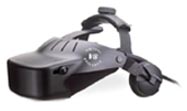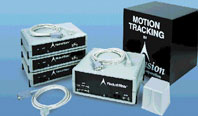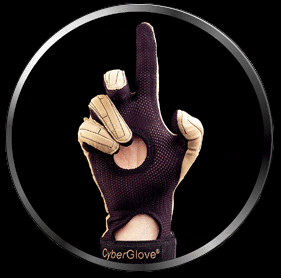
Virtual Research V8 Helmet.
|
||
|
||
|
||
Dateline: May 5, 2001
Virtual Reality, or VR, has been hyped up for over a decade. What is it and should you care?
First let's get a few terms straight. When I talk about Virtual Reality what I mean is immersive virtual reality. This is as opposed to non-immersive vr, and we'll get all these terms straight.
VR is simple to understand. The idea is to show you, the user or viewer, a computer generated environment that adjusts to you, to your movements. To be specific the idea is that when you turn your head and for example, look up to see a computer generated sky, the sky is there. When you look down the ground is there. Now we got a problem though, a computer generated scene is going to be displayed on a monitor. If the monitor is on your desk and you turn your head up, it's kind of hard to see the scene. So now we have the HMD (Head Mounted Display) which basically are those cool looking helmets people wear. Inside the helmet is a display to that as you turn your head, the display is still in front of your eyeballs. Simple idea but not so simple to execute well. One of the big problems is that when you strap a monitor to your face, preferably one in front of each eyeball, the display's are small and usually of low resolution. High resolution displays are now available but expensive. They are getting better and cheaper all the time. You can also use the helmets to just sit and watch videos! I've even seen some airports rent portable DVD players with these displays that you can take with you on airplanes.
The helmet is only part of the VR equation. In order for the computer to adjust the display it had to know your head's position. Specifically it needs to know the position of your head in space and the orientation of your head.
Actually if you are sitting still in a chair and you turn your head around without getting up the position information isn't as important as the orientation information. So this magic is accomplished by devices called position trackers. Position trackers are not cheap. They typically cost several thousand dollars. They work using a variety of technologies each with advantages and disadvantages. There are links to lots of these devices on the VR Hardware page.
Getting back to basics though, if you're sitting in front of a computer with a helmet on and the helmet has a position tracker attached (a typical setup) you now have an immersive VR system. The computer graphics scene generated from the computer will be routed to the helmet and the position information of your head, will be routed via the position tracker to the computer. Often the position information can be communicated via a simple serial port, just like your modem. Although that is not the fastest way, which would be via a dedicated interface card in the computer.
Ok so now we have a computer generated scene which adjusts to the viewers head position. The next thing we need is the ability to interact with the scene. To touch stuff in the scene. This is where the infamous gloves come in. VR glove devices, also not cheap, are devices that are spcialized position, orientation sensors. Specialized software reads the position of the hand along with the positions of the figures to let you make gestures of various sorts to let you fly around a scene, select objects, manipulate controls and so on.
The final component for a good immersive VR system is spatialized sound. Often the helmets you get have earphones. The computing environment can have sounds associated directly with objects or people floating around in the virtual world. Attaching sounds and getting the sensation of object locations via sound cues is an effective technique to highten the immersive effect.
That's pretty much the basics of immersive VR. There are of course lots of other types of devices and sensors.
See you in cyberspace!

Ascention Flock of Birds Motion Tracker

Virtual Technologies CyberGlove

[Tutorials] [Web3D Technology Comparison] [3D Resources]
[Virtual Reality] [Art] [People of Web3D]
[Web3D Glossary] [FAQs] [Companies]